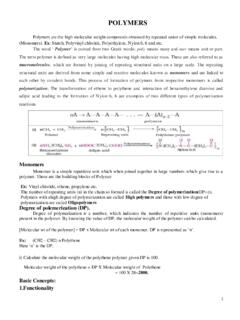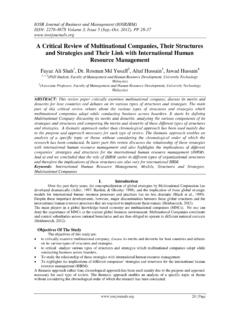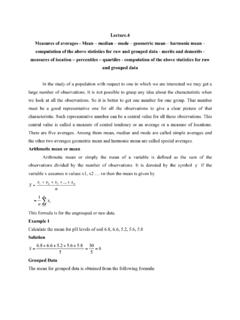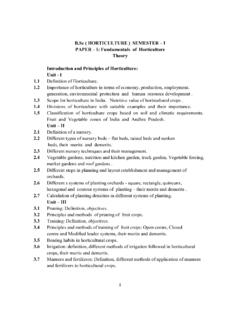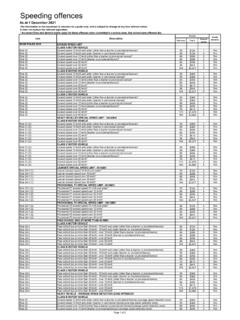Transcription of UNIT IV CAPITAL BUDGETING - Annamacharya Institute of ...
1 UNIT IV CAPITAL BUDGETING CAPITAL BUDGETING : CAPITAL BUDGETING is the process of making investment decision in long-term assets or courses of action. CAPITAL expenditure incurred today is expected to bring its benefits over a period of time. These expenditures are related to the acquisition & improvement of fixes assets. CAPITAL BUDGETING is the planning of expenditure and the benefit, which spread over a number of years. It is the process of deciding whether or not to invest in a particular project, as the investment possibilities may not be rewarding. The manager has to choose a project, which gives a rate of return, which is more than the cost of financing the project. For this the manager has to evaluate the worth of the projects in-terms of cost and benefits.
2 The benefits are the expected cash inflows from the project, which are discounted against a standard, generally the cost of CAPITAL . CAPITAL BUDGETING Techniques: The CAPITAL BUDGETING appraisal methods are techniques of evaluation of investment proposal will help the company to decide upon the desirability of an investment proposal depending upon their; relative income generating capacity and rank them in order of their desirability. These methods provide the company a set of norms on the basis of which either it has to accept or reject the investment proposal. The most widely accepted techniques used in estimating the cost-returns of investment projects can be grouped under two categories.
3 1. Traditional methods 2. Discounted Cash flow methods 1. Traditional methods These methods are based on the principles to determine the desirability of an investment project on the basis of its useful life and expected returns. These methods depend upon the accounting information available from the books of accounts of the company. These will not take into account the concept of time value of money , which is a significant factor to determine the desirability of a project in terms of present value. A. Pay-back period method: It is the most popular and widely recognized traditional method of evaluating the investment proposals. It can be defined, as the number of years required to recover the original cash out lay invested in a project.
4 According to Weston & Brigham, The pay back period is the number of years it takes the firm to recover its original investment by net returns before depreciation, but after taxes . According to James. C. Vanhorne, The payback period is the number of years required to recover initial cash investment. Payback period = ( ) Merits: 1. It is one of the earliest methods of evaluating the investment projects. 2. It is simple to understand and to compute. 1. It dose not involve any cost for computation of the payback period 2. It is one of the widely used methods in small scale industry sector 3. It can be computed on the basis of accounting information available from the books.
5 Demerits 1. This method fails to take into account the cash flows received by the company after the pay back period. 2. It doesn t take into account the interest factor involved in an investment outlay. 3. It doesn t take into account the interest factor involved in an investment outlay. 4. It is not consistent with the objective of maximizing the market value of the company s share. 5. It fails to consider the pattern of cash inflows i. e., the magnitude and timing of cash in flows. B. Accounting (or) Average rate of return method (ARR): It is an accounting method, which uses the accounting information repeated by the financial statements to measure the probability of an investment proposal.
6 It can be determine by dividing the average income after taxes by the average investment , the average book value after depreciation. According to Soloman , accounting rate of return on an investment can be calculated as the ratio of accounting net income to the initial investment, , ARR= Average income after taxes= . Average investment = 2 On the basis of this method, the company can select all those projects who s ARR is higher than the minimum rate established by the company. It can reject the projects with an ARR lower than the expected rate of return. This method can also help the management to rank the proposal on the basis of ARR.
7 A highest rank will be given to a project with highest ARR, where as a lowest rank to a project with lowest ARR. Merits 1. It is very simple to understand and calculate. 2. It can be readily computed with the help of the available accounting data. 3. It uses the entire stream of earning to calculate the ARR. Demerits: 1. It is not based on cash flows generated by a project. 2. This method does not consider the objective of wealth maximization 3. IT ignores the length of the projects useful life. 4. It does not take into account the fact that the profits can be re-invested. II: Discounted cash flow methods: The traditional method does not take into consideration the time value of money. They give equal weight age to the present and future flow of incomes.
8 The DCF methods are based on the concept that a rupee earned today is more worth than a rupee earned tomorrow. These methods take into consideration the profitability and also time value of money. A. Net present value method (NPV) The NPV takes into consideration the time value of money. The cash flows of different years and valued differently and made comparable in terms of present values for this the net cash inflows of various period are discounted using required rate of return which is predetermined. According to Ezra Solomon, It is a present value of future returns, discounted at the required rate of return minus the present value of the cost of the investment. NPV is the difference between the present value of cash inflows of a project and the initial cost of the project.
9 According the NPV technique, only one project will be selected whose NPV is positive or above zero. If a project(s) NPV is less than Zero . It gives negative NPV hence. It must be rejected. If there are more than one project with positive NPV s the project is selected whose NPV is the highest. The formula for NPV is NPV= Present value of cash inflows investment. NPV= + + ( + )+ ( + )+ ( + ) Co- investment C1, C2, Cn= cash inflows in different years. K= Cost of the CAPITAL (or) Discounting rate D= Years. Merits: 1. It recognizes the time value of money. 2. It is based on the entire cash flows generated during the useful life of the asset 3. It is consistent with the objective of maximization of wealth of the owners.
10 4. The ranking of projects is independent of the discount rate used for determining the present value. Demerits: 1. It is different to understand and use. 2. The NPV is calculated by using the cost of CAPITAL as a discount rate. But the concept of cost of CAPITAL . If self is difficult to understood and determine. 3. It does not give solutions when the comparable projects are involved in different amounts of investment. 4. It does not give correct answer to a question whether alternative projects or limited funds are available with unequal lines. 5. B. Internal Rate of Return Method (IRR) The IRR for an investment proposal is that discount rate which equates the present value of cash inflows with the present value of cash out flows of an investment.



